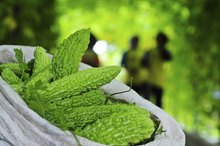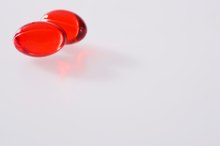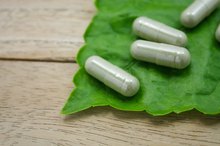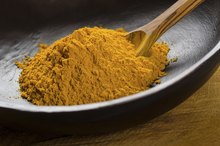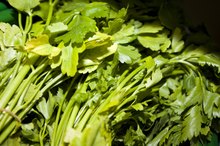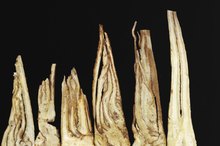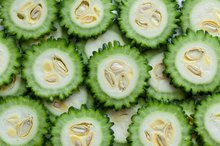Definition of Ampalaya
Ampalaya, or Momordica charantia, is a tropical plant largely found in Asia, South America, East Africa and the Caribbean. Often referred to as bitter melon or bitter gourd, its fruit is used in both food preparation and alternative medicines 3. The juice, seeds and oil extract of the unripened fruit are thought to hold medicinal qualities due to the high concentration of vitamins, minerals and alkaloids. Supplementing the diet with the fruit, juice or extract is said to prevent or treat a number of diseases, disorders and infections.
If you are experiencing serious medical symptoms, seek emergency treatment immediately.
Uses
Due to its blood sugar-lowering properties, bitter melon is most commonly used in the treatment of diabetes 3. It's also shown promise in treating leukemia, breast cancer and HIV/AIDS, according to the Memorial Sloan-Kettering Cancer Center 1. The extract has been used to reduce fevers, relieve menstruation symptoms and treat viral infections as well, but lacks research and evidence of its efficacy.
Significance
Bitter Melon & Weight Loss
Learn More
For diabetes, the active substances of the extract act like insulin in your bloodstream. It stimulates the absorption of glucose into cells, and thereby helps to lower blood sugar levels, explains the Memorial Sloan-Kettering Cancer Center 1. The Cancer Center also asserts that bitter melon extract has shown promise in slowing the metastasis of breast cancer cells, while actually killing leukemia cells 3. Studies involving cancer and leukemia have been isolated to animal subjects, so further research is needed to determine its effect on humans. In the treatment of HIV/AIDS, the extract appears to prevent the genetic mutation of healthy chromosomes.
- For diabetes, the active substances of the extract act like insulin in your bloodstream.
- In the treatment of HIV/AIDS, the extract appears to prevent the genetic mutation of healthy chromosomes.
Dosages
The recommended dosages for bitter melon in the treatment of type 2 diabetes is 50 ml to 100 ml of juice a day, 15 g of extract each day or 900 mg of the fruit 3 times a day, but much larger clinical trials are necessary to support these claims 3. With type 1 diabetes, a "plant insulin" preparation injected into patients helped reduce blood glucose exponentially, according to Diabetes Health. But like the trials for type 2 diabetes, only a small number of participants were included in the study, so larger trials are necessary to support use. The actual amounts necessary to slow cancer metastasis, kill leukemia cells and prevent genetic mutation are still unknown. It is for this reason that bitter melon not be used as a replacement therapy for any of these conditions 3. The only option for the extract is as a complementary form of medicine.
Interactions
The Benefits of Bitter Leaf
Learn More
If you do decide to take ampalaya to complement your current treatment plan, talk to your primary health care provider. Bitter melon can adversely interact with other medications 3. It may increase the efficacy of insulin and therefore lower blood glucose below the desired level.
Warning
Taking bitter melon each day may also result in liver damage and favism, which is an enzyme deficiency in the blood 3. Favism can cause fever, headaches, abdominal pain and coma, according to Drugs.com. Bitter melon is also known to be toxic in children and could pose a danger for pregnant women, as it may induce premature contractions, vaginal bleeding and spontaneous abortion 3.
Related Articles
References
- Memorial Sloan-Kettering Cancer Center: Better Melon
- Philippine Herbal Medicine: Ampalaya (Bitter Melon)
- Drugs.com: Bitter Melon
- FoodData central. Bitter melon, cooked, fat not added in cooking. U.S. Department of Food and Agriculture. Updated 2019.
- Yin RV, Lee NC, Hirpara H, Phung OJ. The effect of bitter melon (Mormordica charantia) in patients with diabetes mellitus: A systematic review and meta-analysis. Nutr Diabetes. 2014;4:e145. doi:10.1038/nutd.2014.42
- Alam MA, Uddin R, Subhan N, Rahman MM, Jain P, Reza HM. Beneficial role of bitter melon supplementation in obesity and related complications in metabolic syndrome. J Lipids. 2015;2015:496169. doi:10.1155/2015/496169
- Sagkan RI. An in vitro study on the risk of non-allergic type-I like hypersensitivity to Momordica charantia. BMC Complement Altern Med. 2013;13:284. doi:10.1186/1472-6882-13-284
- Saad DY, Soliman MM, Baiomy AA, Yassin MH, El-Sawy HB. Effects of Karela (Bitter Melon; Momordica charantia) on genes of lipids and carbohydrates metabolism in experimental hypercholesterolemia: biochemical, molecular and histopathological study. BMC Complement Altern Med. 2017;17(1):319. doi:10.1186/s12906-017-1833-x
- Vitamin A fact sheet for health professionals. National Institutes of Health. Office of Dietary Supplements. Updated 2020.
- Sagkan RI. An in vitro study on the risk of non-allergic type-I like hypersensitivity to Momordica charantia. BMC Complement Altern Med. 2013;13:284. doi:10.1186/1472-6882-13-284
- Bitter melon. Memorial Sloan Kettering Cancer Center. Updated 2019.
- Bitter melon and diabetes. Diabetes.co.uk. Updated 2019.
- Bitter melon (momordica charantia). UIC Heritage Garden.
- Bitter melon. Tennessee State University. College of Agriculture, Human and Natural Sciences Ornamental Horticulture.
Writer Bio
Based in Minneapolis, Minn., Dana Severson has been writing marketing materials for small-to-mid-sized businesses since 2005. Prior to this, Severson worked as a manager of business development for a marketing company, developing targeted marketing campaigns for Big G, Betty Crocker and Pillsbury, among others.
